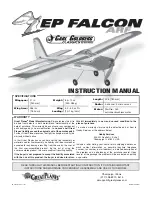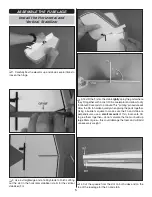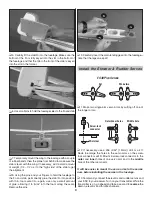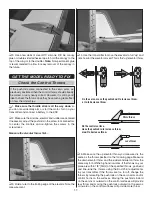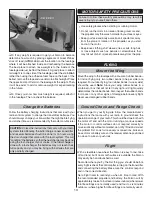
8
Refer to this photo for the following three steps.
❏
2. With the ESC connected to the receiver, guide the three
motor wires from the ESC down through the fuselage and
through the curved slot for the wires in the back of the fi rewall.
Connect the wires to the motor.
❏
3. Before mounting the propeller, connect the motor and a
battery to the ESC. Make sure the throttle channel is reversed,
then use the radio to run the motor to make sure it is turning
in the correct direction (counter-clockwise when viewed from
the front). If the motor is
not
turning the correct direction, swap
any of the two motor/ESC wires with each other to make the
motor turn the right way.
❏
4. The propeller may be mounted to the motor later, but it
is easier to do now, before the motor has been mounted to
the fuselage. If you mount the propeller now, fi rst balance it
as instructed on page 12.
❏
5. Mount the motor to the fi rewall with the three 2mm x
8mm washer-head Phillips screws.
❏
6. Coil up the rest of the motor wires and place the ESC
and the wire in the fuselage behind the fi rewall. Hold it to
the inside of the fuselage with Velcro
®
or double-sided foam
mounting tape.
❏
7. Guide the servo and ESC wires out through the lightening
hole in the bottom of the fuselage just ahead of the landing
gear. Then, connect the wires to the receiver. Also connect
a 6" [150mm] servo extension wire to the aileron channel in
the receiver.
❏
8. Mount the receiver to the bottom of the servo tray with
Velcro or double-sided foam adhesive tape.
❏
9. Apply a 1/4" [6mm] strip of the softer “loop” side of the
adhesive-backed Velcro material to your battery and mount it to
the “hook” side of the Velcro already in the nose of the fuselage.
Hook Up the Elevator and Rudder
❏
1. Guide the
elevator
and
rudder
pushrods
up through
the guide tubes in the fuselage. Connect the pushrods to
the
middle
holes in the rudder and elevator horns with the
90-degree pushrod connectors. (It may be necessary to slightly
enlarge the holes in the horns with a hobby knife to get the
pushrods to fi t—but be careful—don’t oversize the holes. Just
a few twists of the blade should do it.)
❏
2. With the radio on and the trims centered, lock the
elevator, rudder and nose-steering pushrods into the screw-
lock connectors by tightening the screws—don’t forget to use
a
small
drop of threadlocker on the threads of the screws and
make sure each control is centered when tightening the screws.
❏
3. With the radio on, roll the fuselage along the fl oor to see if
it goes straight. If necessary, adjust the nose-steering pushrod
in the screw-lock connector to get the model to roll straight.
Содержание EP FALCON ARF
Страница 16: ......

